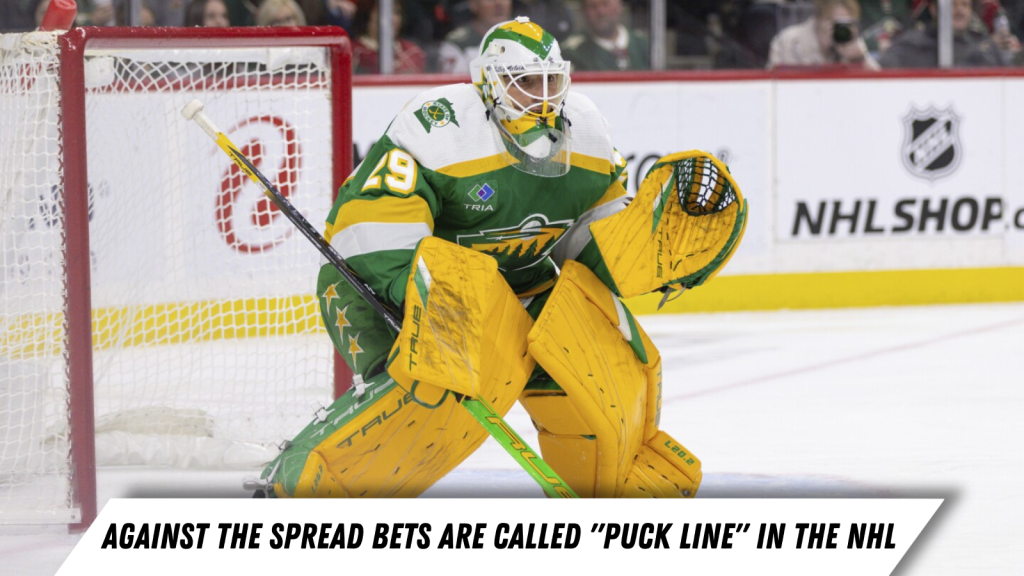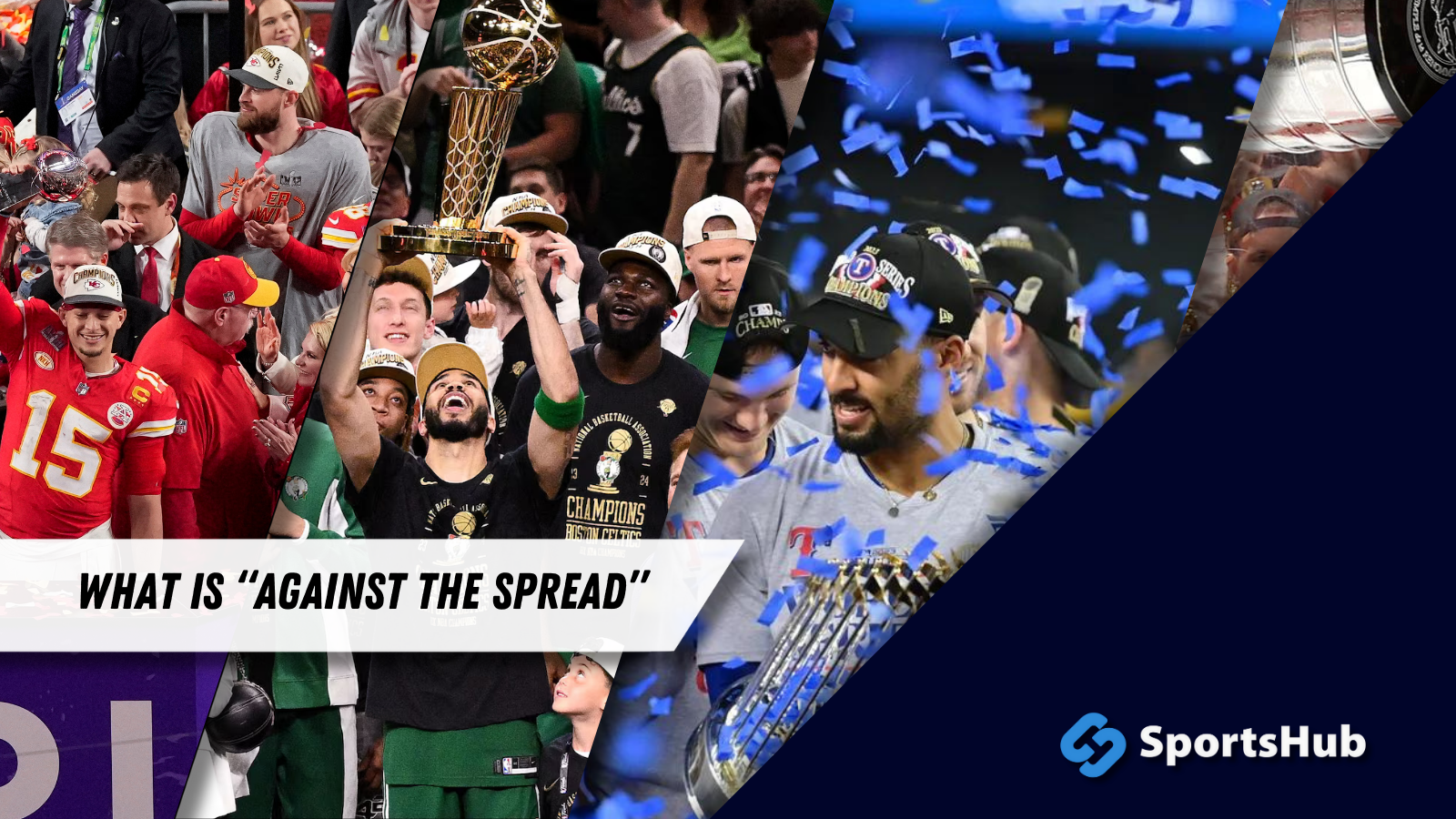Do you know what “against the spread” (ATS) means in sports betting? In this betting guide, we explain what against the spread means using examples and we examine all of the possible outcomes.
The first thing to understand is that “ATS” is short for “against the spread” in sports betting.
Against the spread bets are most common in the NFL and NBA, but there are also spread bets in MLB (run line), NHL (puck line) and soccer (Asian handicaps). The goal with point spreads is to balance the odds. In the NFL and NBA, the majority of spread bets will have the same odds (-110/-110) on both sides.
For tips on placing smart bets, check out our guide on How to Bet on Baseball.
What Does Against the Spread (ATS) Mean?
Point spreads are utilized by sportsbooks to create a balanced betting market. Often, one team is better than their opponent, so a spread is used to balance the betting odds. Let’s look at an example now.
Here are the moneyline odds and point spread odds for an upcoming NBA game:
- Moneyline Odds: 76ers (+410) vs. Cavaliers (-550)
- Point Spread Odds: 76ers +11 (-110) vs. Cavaliers -11 (-110)
Never too early to ask…
— NFL (@NFL) February 12, 2024
Who's raising the Lombardi in New Orleans in 2025? pic.twitter.com/xe3WTAVA8O
The Cavaliers are the favorites in this example and the 76ers are the underdogs. With a moneyline bet, the goal is to predict the winner of the game. However, there’s a huge disparity in the moneyline odds.
The Cavaliers have -550 moneyline odds, which means a bettor needs to bet $550 to win $100. Philly are priced at +410, which means a $100 bet would pay $410 profit. With the point spread bet, the odds are both -110, which means you need to bet $110 to win $100 on either side. The spread balances the odds.
The main thing to understand with against the spread bets is that the favorite (negative point spread) will need to win by more than the spread for the bet to be a winner and the underdog (positive point spread) can lose by less than the spread and still win the bet. Spread bets can also end in a tie (push).
Betting Against the Spread Possible Outcomes
Let’s look at the possible outcomes of an against the spread wager to better illustrate how this market works. We’ll use the same example as above to analyze the possible outcomes.
- Against the Spread Example: 76ers +11 (-110) vs. Cavaliers -11 (-110)
Outcome #1 – Cavaliers Cover Against the Spread: The Cavaliers will cover ATS if they win the game by 12 or more points. A $110 bet will return $210 ($110 original stake + $100 in profit).
Outcome #2 – 76ers Cover Against the Spread: The 76ers will cover ATS if they win the game or lose the game by 10 or fewer points. Underdogs can lose a game, but still cover against the spread (win).
Outcome #3 – Neither Team Covers Against the Spread: When a point spread is a whole number, such as in our example, the bet can tie. This is also known as a “push” in sports betting. The only way the bet can push is if the Cavaliers win the game by exactly 11 points. If the bet pushes, your stake is returned.

Understanding Against the Spread (ATS) Payouts
Now that you understand against the spread bets are utilized to balance the odds, you may be wondering how the payouts for this wager work. Online sportsbooks essentially make a 50/50 betting market by implementing a spread for a game, but the payout odds aren’t even money.
A 50/50 proposition should have even money odds (+100/+100). However, sportsbooks create an edge against bettors by charging a commission on every bet. The commission (juice/vig) varies, but for ATS bets, most sportsbooks will have -110/-110 odds, which equates to a 4.8% house edge.
Interested in calculating the house edge? Enter the odds for one side of the market into an odds converter calculator to get the implied probability. If the odds are -110, the implied probability is 52.4%. Since the odds are the same for both sides of our example, we can multiply 52.4% by two to get 104.8%. Now we simply take 104.8% and subtract 100%, which gives us the house edge of 4.8%.
Learning how to bet on basketball offers a strong foundation for other sports
ATS Betting – Why Do Spreads and Odds Move
You may be wondering why the point spreads and odds move when ATS betting. We’ll look at the reasons why spreads and odds can fluctuate and discuss the importance of shopping for the best lines.
There are a number of reasons spreads and odds can move, including betting volume, injuries, weather, team news and sharp bettors (professionals). Oddsmakers set the spreads for each game where they believe both sides will get equal action, but they’ll move the spreads based on the factors discussed.
For example, the Chiefs might open as a -3.5 point favorite. A few sharp bettors place big bets on the Chiefs to cover the -3.5 point spread and the oddsmakers move the line to Chiefs -4.5. In some cases, the odds can move as well. For example, a team getting heavy action against the spread at -110 odds could see their odds move to -115 or -120 instead of the point spread moving.
The point spreads and odds will vary by sportsbook due to betting volume and other factors that might only impact a single sportsbook. For example, one sportsbook might move the Chiefs line to -4.5, but if you shop around, you’ll still be able to bet the Chiefs -3.5 at another sportsbook.
Always shop for the best spread and odds before placing against the spread wagers.
Every great dunker needs an assist man!
— NBA History (@NBAHistory) February 11, 2024
Take a look back at the best #ATTSlamDunk contest dunks where the dunkers got an assist from a teammate 🌟#StateFarmSaturday: 2/17, 8:00pm/et on TNT pic.twitter.com/2hLXo4ncae
Against the Spread Betting Terms
We’ll conclude our against the spread betting guide, by defining common terms with this betting market.
- Point Spread: The point spread creates a more balanced betting market. The point spread is the margin of victory the favorite needs to win by or the margin of defeat the underdog can lose by.
- Favorite: The favorite is the team expected to win and will have a negative point spread.
- Underdog: The underdog is the team expected to lose and will have a positive point spread.
- Cover Against the Spread: The term “cover against the spread” or “cover the spread” is used by bettors to discuss point spread bets. The favorite will cover the spread if they win by more than the spread, while the underdog will cover the spread if they don’t lose by more than the spread.
- Push: A push is a tie and can happen when the point spread is a whole number. When an ATS bet pushes, the amount you bet will be returned to your balance when the bet is graded.
- Vigorish (Vig / Juice): The vigorish is the commission charged by sportsbooks.






